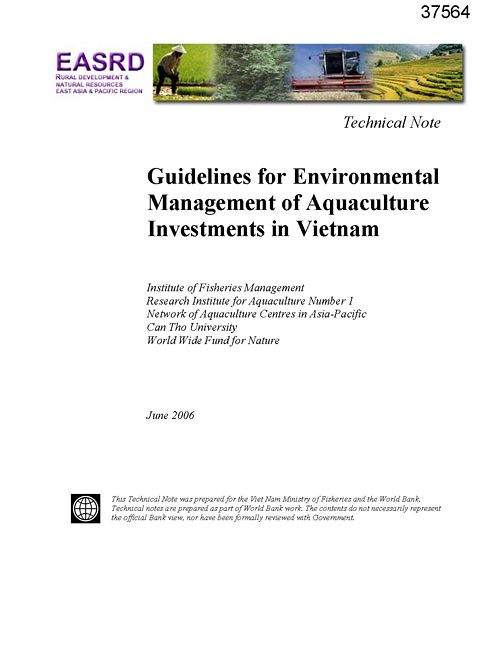Guidelines for environmental management of aquaculture investments in Vietnam
15 November 2006 | 3332 Downloads | .pdf | 2.22 MB | Better management practices, Environment and Sustainability, Vietnam
The 2004 Viet Nam fisheries and aquaculture sector study, conducted by the Ministry of Fisheries (MOFI) of the Government of Viet Nam (GOV) and the World Bank, concluded that the sector shows considerable potential to contribute to economic growth and poverty reduction in Viet Nam. The study also noted that aquaculture development had, particularly in coastal areas, contributed to environmental problems, such as deterioration of coastal habitats and other environmental impacts. With ambitious government plans for further expansion of the aquaculture sector, including aquaculture export targets of US$2.5 billion by 2010, improved environmental management of the sector will be essential for its sustainable growth.
This document provides an analysis of the environmental impacts and risks associated with aquaculture development in Viet Nam and guidance on better environmental management and monitoring for its future development. Part 1 provides a summary of the main findings, and guidelines for future development of the aquaculture sector. Part 2 provides the detailed case study findings.
The guidelines presented in Part 1 are based on cases studies of all major aquaculture commodities in Viet Nam, but gives special attention to aquaculture systems appropriate for poor coastal and inland provinces in northern, central and southern areas of Viet Nam. The document provides individual chapters covering each of the following major farming system/commodities:
- Coastal shrimp aquaculture.
- Marine cage farming of grouper/cobia.
- Marine cage farming of lobsters
- Freshwater cage and pond culture of Pangasius catfish.
- Freshwater cage culture of carps, emphasizing grass carp.
- Freshwater pond culture of carps/tilapia and integrated fish farming.
- Coastal mollusc farming (clams).
- Coastal seaweed farming.
Based on the findings from the case studies, the document assesses the environmental issues and identifies recommended better management practices. The purpose is to provide a concise set of guidelines to assist in future development of the sector.
The final part of the document provides key recommendations for implementation of the environmental guidelines; it emphasizes that public and private investment in environmental management and monitoring capacity will be critical to sustaining Vietnamese aquaculture and its importance for Viet Nam's economy.
Copyright, all rights reserved.

